How to keep your food fresh and chilled while you're camping
One of the best things about camping holidays is enjoying local produce from the area you are visiting, but how do you keep food fresh and drinks chilled in your tent, especially in the height of summer?
Page contents
- Keeping food fresh
- Coolbags
- Insulated coolboxes (non-electric)
- Electric-coolboxes
- Top tips for keeping food cool in a tent
- Coolboxes, coolbags and camping fridges put to the test
- About our magazine
Keeping food fresh
A camping trip can mean picking up fresh seafood from a harbour fishmonger or a visit to a farm shop to stock up on locally produced sausages, bacon or cheese.
Even a basic supermarket shop will involve buying fresh food and drink that needs to be kept refrigerated or it will quickly go off, like milk, butter and ham.
And there’s nothing more refreshing on a hot summer’s day than a cold beer, a chilled glass of wine or a cool soft drink as you sit on the campsite soaking up the sun’s rays.
But how do you keep food fresh and drinks cold in the height of summer when you are camping? There are a number of options available, including basic coolbags, passive and electric coolboxes and electric fridges and our guide will explain them all so you can decide what is the best option for you.
Coolbags
A coolbag is ideal if you want to keep food and drink cool for a few hours. Soft insulated coolbags are relatively cheap and are a lighter and less bulky option than a coolbox.
Coolbags rely on insulation to keep their contents cold, and the soft sides allow you to squash them flat so they take up very little space while not in use.
They can be used with a variety of freezer blocks or ice packs to help keep food fresh and drinks cool.
Most campsites have a freezer for campers to refreeze their ice packs, although some make a small charge. Write your name on your freezer pack using a permanent marker. Having two sets – one in use, one in the freezer – makes tent life easier.
Pre-chilling drinks and freezing food helps to lower the temperature in the coolbag for longer.
The waterproof inners are easy to wipe down and some coolbags come with a removable hard plastic lining to give them more rigidity.
They come in a variety of sizes, from small bags that will hold a couple of cans of drinks and a sandwich up to 30-litre coolbags that will hold a full picnic.
Coolbags are best suited for picnics, walks in the hills or for keeping items cool until you reach somewhere with a proper fridge. They are handy, too, at home for carrying frozen food back from the supermarket.
You can also buy coolbags that are, to all other purposes, coolboxes – with electric supply, cooling fans etc.
For a one-night camping trip, you could probably get away with using a coolbag to keep your milk and bacon cool overnight.
But for longer holidays you might want to look at something more substantial.
Get Camping magazine for just £4.99 per year.

Just £4.99 per year! That is less than 10p per week.
Camping is the UK's only magazine devoted to the wonderful world of life under canvas. Every issue is packed with inspirational travel, the top camping sites, reviews, practical help and much more.
Camping’s fully searchable digital library gives you access to the latest issues, plus every edition of Camping since September 2016.
Insulated coolboxes (non-electric)
With far more capacity, solid sides and superior insulation qualities, a coolbox is generally a better performer than a coolbag.
An insulated coolbox, sometimes called a passive coolbox, is a non-electric version, which is usually made out of heavy-duty plastic, with thick insulated walls and lid and a carry handle to make it portable.
The largest models have wheels and a telescopic handle to let you pull it along behind you.
A good-sized coolbox will store a good selection of chilled food and drink – with some big enough to take a two-litre drink bottle and is a good option for longer camping trips.
The insulation works along with freezer blocks and ice packs to keep the contents cool, with some promising to work for up to 48 hours. You will need to regularly refreeze your blocks if you are camping for more than a couple of days.
The ambient temperature will have an impact on the ability of the box to keep produce chilled so they are best suited for camping in the UK or northern Europe, rather than in the hottest destinations.
Keeping it in the shade will help extend its cooling function.
The sturdiest coolboxes have the added bonus that you can also use them as makeshift seating around the tent.
Generally the cheaper the product the less you can expect from it in terms of performance – although, of course, size does come into it, too.
The downside is that coolboxes tend to be bulky, and you can’t compress them. Their shape and bulkiness can also make them harder to carry (hence wheels can be a good idea).
Inflatable coolboxes combine the better insulation and larger capacity of solid boxes, with the easier packing of a coolbag.
Electric coolboxes
A step up from insulated coolboxes are ones that work with thermoelectric technology. Most will run off either the 12V connection in your car or leisure battery or via mains electric on site.
These are more effective at keeping your food cool as they allow you to control the temperature settings via the electric fan that draws air into the unit through metal plates.
They won’t keep the contents as cold as your fridge at home, but they are more effective than a passive coolbox.
You should still use freezer packs to help keep the temperature in the box cooler for longer.
They can be quite noisy and again, they work better when the outside temperature is lower, especially if the insulation is not up to scratch.
The hotter the ambient temperature, the harder the fan has to work to keep the contents cool.
Electric fridges
Electric fridges are the most effective option for storing fresh food in a tent. But they are also the most expensive to buy and will cost more to power if you have to pay for the electric hook-up.
Their size means they can store more but that also makes them more tricky to transport.
A three-way camping fridge runs off 12V, mains or gas, and is designed to be used by campers.
They work very effectively and are fairly quiet but must be well ventilated if you are using them with gas.
A camping fridge with a compressor can be even more effective, and can even work as a freezer. Adjustable digital displays allow you to set and monitor the temperature.
The fridge plugs into your car or standard mains sockets. These are especially good for camping abroad in very hot temperatures.
Alternatively you can go all the way up to full-size, full-function mains-operated leisure fridge, which should definitely be a consideration if there’s a lot of you and you’re staying in one place for a long period.
Top tips for keeping food cool in a tent
- For best efficiency, put pre-cooled products in your coolbox, rather than relying on it to cool stuff down. It saves energy and efficiency.
- Open the lid as little as possible. The more you open the lid, the more the all-important cool air escapes and the less effective it is.
- Gel ice packs are a great idea because you can pack them around things. Try to put ice packs towards the top as hot air rises.
- Be careful how you pack. Keep fresh and pre-cooked products (especially meats or fish) apart. Make sure any glass has padding around it for travel.
- Keep the door/lid of your coolbox slightly ajar when it is being stored, to prevent bad odours, or even mould, developing.
Coolboxes, coolbags and camping fridges put to the test
Iain Duff puts a selection of coolboxes, coolbags and camping fridges through their paces. See what he thinks of each one...
#1 Outwell Deep Chill 38
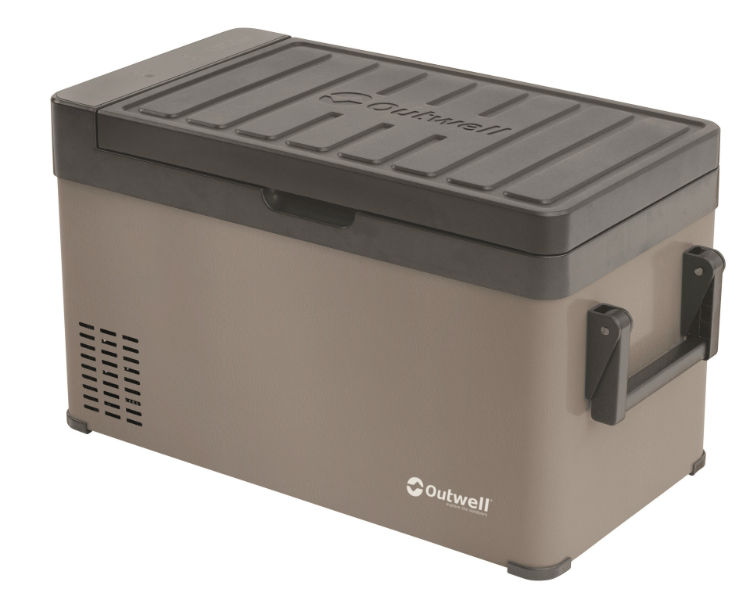
(Photo courtesy of Outwell)
Our review:
In the good old days, keeping your food fresh while camping basically meant wrapping it up in a plastic bag and leaving it in a river overnight. All very Huckleberry Finn, but hardly practical. And unless you were camping in Scotland in mid-January, frozen food wasn’t an option. Technology has changed all that.
A compressor cooler like the Deep Chill 38 is a game changer when it comes to camping, especially if you’re a keen cook and like to have fresh ingredients to hand. It’s fairly expensive at more than £400, but the price reflects its effectiveness. Unlike cheaper thermoelectric coolers that only keep the contents cool to a level below the ambient temperature, it works like a fridge, maintaining a set temperature. That can be as low as -20°C, making frozen food an option. You simply set the temperature you want on the LED display and fill it up.
The Deep Chill features a spacious, removable basket to help organise your supplies. Thie 38L is the middle-sized of three models and I found there was plenty of space for chilled foods inside.
Importantly for camping, the steel body is pretty rugged looking and the spring-loaded handles make it easy to carry. It runs off 12V and mains electric so you can use it in the car and on the campsite, if you have chosen electric hook-up.
It's worth knowing that there were some previous technical issues with this model, which resulted in it being taken off the shelves temporarily. Thankfully, they have now been fully resolved and it should be back on sale now.
Price £405.99
Size 74 x 36 x 40.5cm
Capacity 38L
www.outwell.com
#2 Vango E-Pinnacle 40L
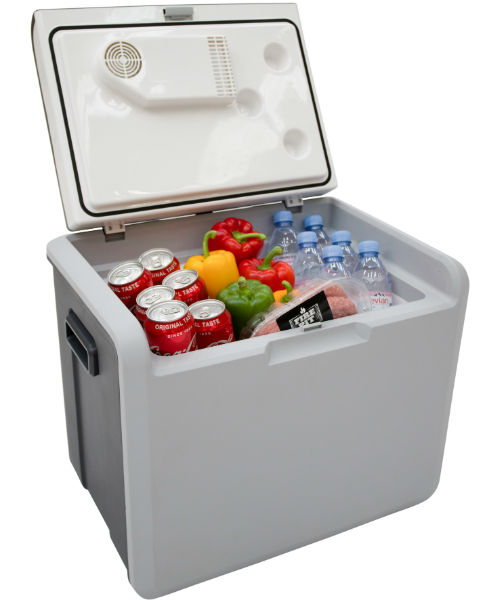
(Picture courtesy of Vango)
Our review:
When it comes to electric coolers, it’s important to understand the difference between thermoelectric and compressor models. The latter basically works like a fridge/freezer at home, where you set it to the level you want and the ambient temperature has little impact on the performance of the box.
Thermoelectric coolers, like Vango’s E-Pinnacle 40L here, are different. These cool the contents to a certain level below the ambient temperature. In this case, it’s around 16°C below, so if it’s sat somewhere where the air is 20°C, inside the box it will drop to around 4°C. The hotter the environment, the harder the cooler has to work to keep the temperature down and the warmer it will be inside. So, bear that in mind – particularly try to keep it in a cool area and out of direct sunlight.
That said, thermoelectric coolers are far cheaper than compressors, and can be a very good option if you want to be able to keep food and drink chilled, even in warm weather, without spending a huge amount.
The E-Pinnacle is spacious enough for milk, a couple of bottles of wine and some fresh food.
It takes around two hours to reach maximum temperature – but you can help things along by making sure the contents are cold when they go in. A bag of ice or even a couple of freezer blocks will also help the efficiency of the box.
The telescopic handle and sturdy wheels make it easy to move around and other features include a built-in cable compartment and two removable dividers for food and drink organising.
Price Around £145
Size 58.5 x 48.5 x 44.5cm
Capacity 40L
www.vango.co.uk
#3 Outdoor Revolution Eco Deep Extreme Compressor Cooler 35L
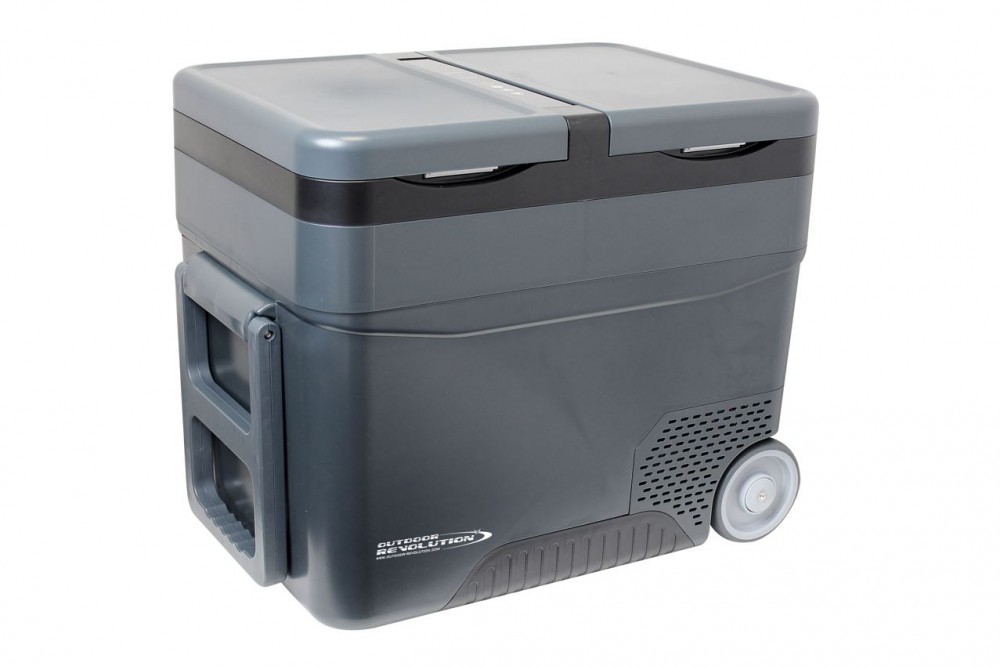
(Photo courtesy of Outdoor Revolution)
Our review:
On a hot summer’s day, what could be better than relaxing by your tent with a cold drink straight out the fridge and a ready supply of ice to keep you cool?
This new range of electric-powered camping coolers from Outdoor Revolution makes that dream a reality.
The Eco Deep Extreme comes in three sizes, all of which are reliable and sturdy, and do exactly what you need them to do at an excellent price. You could pay up to £70 more for a comparable model from another manufacturer, which makes this very good value indeed.
In the twin-compartmented 35 litre version we looked at, the 25 litre fridge area has a temperature range of 0°C to 10°C while the freezer section can operate down to -20°C. The freezer has a 10L capacity, so isn’t massive but I found it to be perfectly sufficient for my camping needs – basically a large bag of ice to keep the G and Ts at a suitable temperature and a box of Magnums! If you do want more freezer space, consider moving up to the 45 litre model which has an extra 5 litres of freezer capacity.
It can be pre-cooled at home before you set off and while away it runs on both 12V and 230V mains, coming with UK and EU plugs. It has wheels and a pull handle so is easy to move around the tent or transport to and from the car, and it feels well-made and sturdy.
Price £329
Size 63.2 x 42 x 42.8cm
Capacity 35L
www.outdoor-revolution.com
#4 Coleman Xtreme Wheeled 50QT
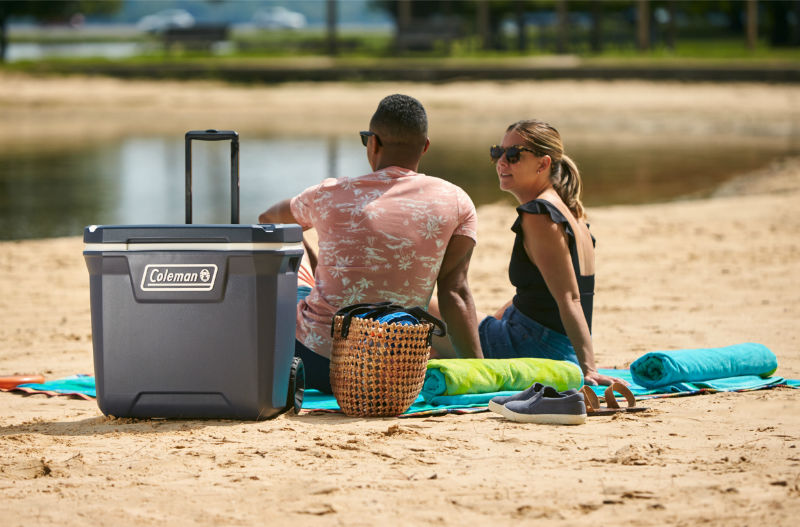
(Photo courtesy of Coleman)
Our review:
Back in 1954, Coleman revolutionised coolbox manufacturing by adding a plastic liner to the design and, in the decades since, the company has become renowned for its quality coolers.
In recent years, it’s been the large, rugged coolboxes that have been most popular, particularly in the camping community.
The legacy continues in 2022, with the new Coleman Xtreme Wheeled 50QT Cooler, part of a whole collection of coolers, with capacities ranging from 26 litres to a gigantic 95 litres. Featuring a new look and modern shape, these high-performing coolers are perfect for storing large amounts of food and drink on the campsite if you don’t have access to electric hook-up. The Xtreme Wheeled 50QT Cooler can hold up to 47 litres, making it a good choice for families. Two sturdy wheels and a telescopic steel handle make it easy to transport over uneven ground, so it’s an excellent option for festivals, too.
Coleman says the thick, injected polyurethane insulation means it will keep food and drink cold for up to four days. Filling every gap of the cavity with insulation ensures there are no areas of weakness, maximising cooling capacity.
But does it actually do what it’s supposed to do – keep your food cold? Well, yes it does. The trick is to make sure everything is as cold as possible to start with and pack the box with freezer blocks. This box won’t actively cool your food, but it will slow down the warming process, keeping it cool for longer. A lot will depend on the external temperature, so keep it in the shade for maximum performance.
Price £120
Size 65 x 49 x 43cm
Capacity 47L
www.colemanuk.co.uk
#5 Easy Camp Chilly 12v coolbox
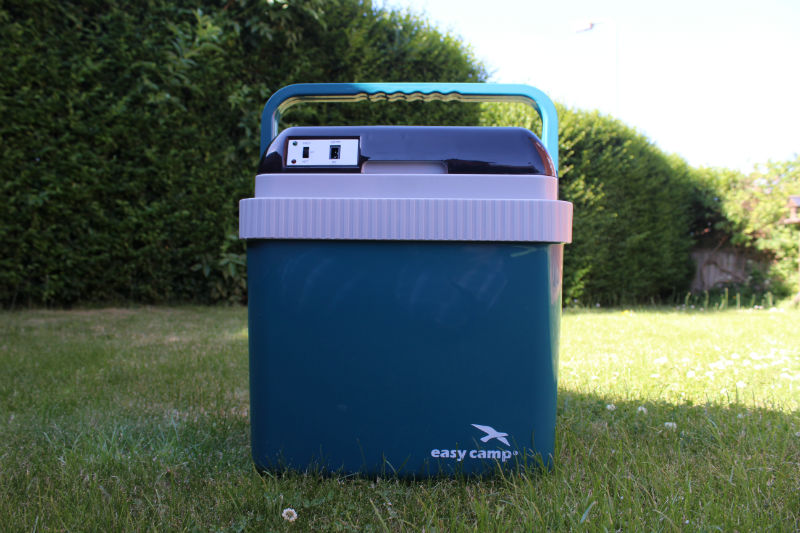
(Photo by Iain Duff)
Our review:
Now that we’re allowed to travel around the UK and beyond again, road trips are back on the agenda. Motorway services, though, are still best avoided, we think. Far better, when you’re racking up the miles en route to a campsite in Cornwall, Cromarty or Carcassonne, is to take your own food supplies for sustenance.
So make a few rounds of sandwiches, pack some pork pies and, of course, lashings of ginger beer, and stash it in this handily sized thermoelectric coolbox. It’s just the right size to squeeze into the boot alongside your camping gear and will run off a 12V socket in the car. It should keep the contents cool to 18°C below the outside temperature. As a bonus, it has a ‘hot’ setting, too, so you can keep your fish suppers warm on the way back from the chip shop!
The lid has three cup holders and the internal divider is a useful feature, as it stops bottles and cans from ratling around inside and potentially getting damaged.
This is not a huge coolbox and, because it’s thermoelectric rather than a compressor, it certainly won’t keep food and drink ice cold. Also, to run it in your tent, you’ll need a 12V power source as it is not designed to be used on the mains. A more expensive 230V version is available.
But it’s ideal for short jaunts where you simply want to keep everything fresh and chilled overnight, and perfect for taking on days out to the beach or anywhere that you could have a picnic.
Price £88.99
Size 40 x 29 x 43cm
Capacity 24L
www.easycamp.com
#6 Kelty Folding Cooler
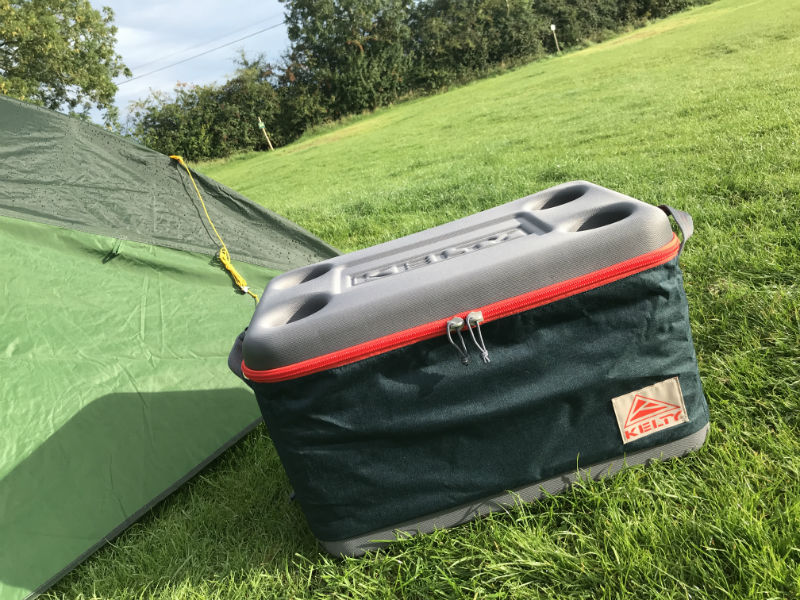
(Photo by Iain Duff)
Our review:
The promotional material that accompanied this soft-sided cooler advises that the 45 litre version holds 70 cans of beer – so that should be just about fine for a weekend of festival camping! Sadly, as Kelty helpfully points out on its website, the tinnies aren’t included, so you’ll have to fill it yourself.
Of course, packing the cooler to the brim with drinks means no space for ice, so if you want a cold beverage you’ll need to sacrifice a few of those cans.
That said, the insulation keeps ice cold for up to 36 hours, so you should be able to get by! When it’s not in use, the coolbox’s semi-rigid sides can be collapsed for easy storage. It’s lightweight, so is easy to carry and, for added convenience, there are handles and four cup holders on the lid.
This is a passive cooler, so make sure your cans – or food, if you insist – is already cold when you pack it in. If you have space, add a couple of frozen ice blocks, as well. The idea is that the insulation will slow down the rate at which the temperature inside the box increases to match the temperature outside, so the colder it is to start with the longer, that process will take. I found keeping it out of direct sunshine helped keep the contents cool. And make sure you close the lid securely every time you go in to get something out.
Price £90
Size 52 x 37 x 34cm
Capacity 45L
www.kelty.com
Finished reading?
Want more great camping equipment information?
Our "Buying camping equipment: How to choose the right gear for you" is full of great kit buying advice.
Expert Camping advice!

Camping magazine has been the voice of campers for over 60 years!
Camping is the UK's only magazine devoted to the wonderful world of life under canvas and the freedom it brings.
Every issue is packed with inspirational travel, the top camping sites to stay on, reviews of the latest tents, camping gear reviews, practical help and much more to help you get the most out of your camping adventures.
Want to know more about Camping magazine?
About Camping magazine







Recent Updates
Camping barbecue: our guide to cooking up a storm this summer
Is there anything more British than sausages grilled on an open flame and dropped on wet grass? Camping and barbecues go hand in hand, which is why ...
Our family camping checklist: everything you need to pack
Sure, you’ve packed the tent and the sleeping bags – but what about slip-on shoes and glow sticks? These are ...
Our guide to planning the perfect camping road trip
Roll down the window, pop on those shades and crank up the volume – it’s time for a road trip. Get ready for ...
Camping in Europe: our 12 top tips
If you’ve not camped in Europe before, there’s a few tips and tricks you’ll need to avoid some continental ...
Solar power for camping: all you need to know
Staying connected in the great outdoors is easier than ever with a solar charger – or is it? How reliable are ...
Wild camping kit list: everything you need for your next adventure
Make sure you’re ready for anything with this list of lightweight camping gear and clothing, including ...
Camping furniture: all you need to know to make your tent a cosy haven
We delve into the essentials of camping chairs, camping tables, and kitchen and bedroom furniture, ensuring ...
Camping lights for tents: What you need to know
We will guide you through all the lighting options available for you and your tent, including interior ...
Camping kitchen: all you need to know
In the great outdoors, a well-equipped camping kitchen transforms mealtime into a delightful adventure ...
How to pack away your camping gear for winter
A complete guide to packing and storing your gear at the end of the season ...
Other Articles
Camping guide to trailers
Trailer stash or trailer trash? Being able to carry lots of other gear when you go camping isn’t such a bad idea, is it? Nick Harding looks at the ...
Winter camping: all you need to know to keep warm
Winter doesn’t have to mean the end of the camping season. With good preparation and the right gear, there’s ...
Camping toilets: a complete guide
If you are wild camping, camping off-grid or the campsite you book onto doesn’t have toilet facilities, you ...
Top tips for camping in windy weather
How to make sure your tent stands up to gusty conditions ...
Camping tents: a complete guide
If you're considering buying a camping tent, whether it's your first time or you're a seasoned camper, making ...
Camping sleeping bags and beds: a complete guide
When it comes to camping, there's one essential item that can make or break your outdoor adventure: the ...
Camping gas: how to use gas on the campsite
A complete guide to using camping gas appliances safely on the campsite, from choosing the right stove to ...
Camping storage: a complete guide
Having problems knowing where to put all your gear when you're camping? Read our top tips and see some great ...
Camping electric hook-up: a complete guide
This is everything you need to know about using electricity on a campsite, including how to hook up ...
How to pack all your camping gear into your car
Planning a family camping holiday? Find out the best way to fit all the kit you need into your car boot, roof ...